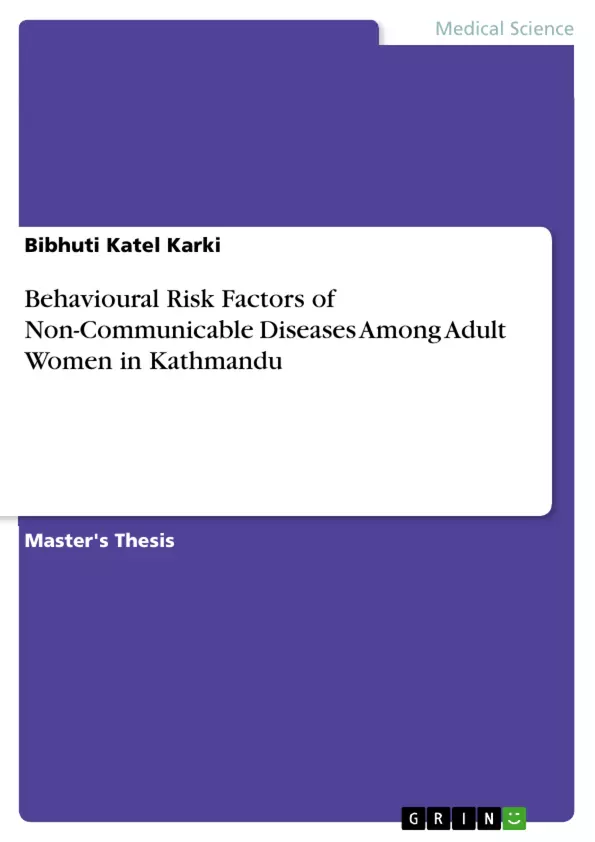Non-Communicable Diseases are the leading cause of death worldwide causing nearly 80% of deaths in low and middle-income countries. The World Health Organization has identified certain risk factors that are associated with an increase in the occurrence of Non-Communicable Diseases: they are physical inactivity, tobacco use, alcohol use and unhealthy diets.
A cross-sectional descriptive research design was used to assess the status of behavioural risk factors regarding Non-Communicable Diseases among the adult women of Gothatar Village Development Committee, Kathmandu. A total of 156 women were taken by using cluster random sampling technique. A semi-structured questionnaire developed on the basis of Non Communicable Diseases Risk Factors: STEPS Survey Nepal 2013 was used and face to face interview was done to collect the data. The analysis was done by using descriptive statistics (frequency, percentage, mean, standard deviation) and inferential statistics (Chi Square test, Fisher's exact test and Odds ratio).
The finding of the study revealed that 91.9% of women were taking inadequate fruit and vegetables as recommended by World Health Organization. Current smoking was present in 7.7% respondents, where older people were more likely to be current smoker (p=<0.001), current alcohol consumption was present in 7.1 % and was higher in underprivileged (p=0.020). Physical inactivity was found in 6.4% with 6 time higher prevalence among older age group. Nearly half (51.9%) of women were found to be overweight and obese. Systolic hypertension was present in 9% and diastolic hypertension in 13.5% of the respondent.
The finding of study concluded that the use of smoking was higher among older women and among those women with education level below primary level. Alcohol consumption was found to be more among women of underprivileged group. The study highlighted the poor dietary habit among women indicating the need of education and awareness raising programs on diet and nutrition.
Inhaltsverzeichnis (Table of Contents)
- CHAPTER I: INTRODUCTION
- 1.1. Background of the Study
- 1.2. Need for the Study
- 1.3. Objectives of the Study
- 1.4. Significance of the Study
- 1.5. Conceptual Framework
- 1.6. Hypothesis/ Research questions
- 1.7. Operational Definitions
- 1.8. Delimitation
- CHAPTER II: REVIEW OF LITERATURE
- 2.1. Introduction
- 2.2. Review of Literature
- 2.2.1 Overview of Non Communicable Disease
- 2.2.2 Tobacco Use
- 2.2.3Alcohol Consumption:
- 2.2.4 Dietary Habit
- 2.2.5 Physical Inactivity:
- 2.2.6 Biological risk of Non communicable Diseases
- Obesity
- Hypertension
- 2.3. Summary of Reviewed Literature
- CHAPTER III: METHODOLOGY
- 3.1. Research Design
- 3.2. Research Setting and Population
- 3.3. Sampling
- 3.4. Instrumentation
- 3.5. Data Collection Procedure
- 3.6. Ethical Considerations
- 3.7. Data Analysis Procedure
- CHAPTER IV: FINDINGS OF THE STUDY
- CHAPTER V: DISCUSSION, CONCLUSION AND RECOMMENDATION
- 3.1. Discussion
- 3.2. Conclusion
- 3.3. Limitations
- 3.4. Implications
- 3.5. Recommendations for Further Study
- REFERENCES
Zielsetzung und Themenschwerpunkte (Objectives and Key Themes)
This thesis aims to assess the status of behavioral risk factors related to non-communicable diseases (NCDs) among adult women in Gothatar VDC, Kathmandu. The study analyzes data collected through a cross-sectional descriptive research design to understand the prevalence of these risk factors.
- Prevalence of tobacco consumption among adult women.
- Status of alcohol consumption among adult women.
- Dietary habits of adult women.
- Physical activity levels of adult women.
- Association between selected socio-demographic variables and behavioral risk factors for NCDs.
Zusammenfassung der Kapitel (Chapter Summaries)
Chapter 1, Introduction, establishes the context of the study by highlighting the global burden of non-communicable diseases and the importance of addressing behavioral risk factors in Nepal. The chapter outlines the research objectives, significance, and conceptual framework.
Chapter 2, Review of Literature, provides a comprehensive overview of the existing research on non-communicable diseases and related behavioral risk factors, drawing on studies from Nepal and other countries. The chapter explores the prevalence of tobacco use, alcohol consumption, unhealthy dietary habits, and physical inactivity among women, and analyzes the associated health consequences.
Chapter 3, Methodology, details the research design, study setting, sampling methods, instrumentation, data collection procedures, ethical considerations, and data analysis techniques used to assess behavioral risk factors among adult women in Gothatar VDC.
Schlüsselwörter (Keywords)
This research focuses on behavioral risk factors for non-communicable diseases among adult women in Nepal. Key concepts explored include tobacco use, alcohol consumption, inadequate fruit and vegetable consumption, physical inactivity, overweight and obesity, and hypertension.
- Quote paper
- Bibhuti Katel Karki (Author), 2015, Behavioural Risk Factors of Non-Communicable Diseases Among Adult Women in Kathmandu, Munich, GRIN Verlag, https://www.grin.com/document/306178



